Appendix 2
Written Communication
In the earlier chapters, you have learnt how to read, speak, listen and participate in discussions. Of all the skills you need to acquire, writing is the most difficult and complex. There are many things to take care of: from conceptualizing what you are going to write about and how you will go about it, to doing research, organizing the information, and writing it all down, and then editing and formatting your text for presentation. So before you even begin to write, you need to have a lot of things clear in your head about communication in general. We hope that whatever you've learnt in the previous chapters will help you to think and write better.
Note Taking and Note Making
Note Taking
Note taking is a method of writing down the crucial items of a lecture, a meeting or a reading text rapidly, briefly and clearly. Studies show that we tend to forget a good part of a lecture within 24 hours. Unless one has excellent memory, one should take notes for future reference. Whether you are a high-school student or a university scholar or a professional, the ability to take effective, meaningful and comprehensive notes is an important skill. Good notes save our study time as they help us review the text for reuse during test preparations, assignments and meetings. At the same time, taking notes helps us concentrate in class and facilitates a deeper understanding of a topic. Two major questions relate to note taking—what to write and how to write.
What to Write
While taking notes, only the most important parts of a lecture/text should be included. If you try to write down everything your professor is saying, you will not be able to keep up and after a while will lose track of the entire lecture. Listen or read carefully for key words/phrases and jot them down. Try to analyse the relations between points and write down any questions or comments that come to your mind.
Focus on the following:
- What is new to you? There is no use in writing down facts you already know.
- What is relevant? Focus on the points that are directly related to your reading material. The details on which you should pay special attention are—dates, numbers, titles, names of people and books, theories, concepts, definitions, arguments, diagrams, exercises, speaker's conclusion, comments of the other listeners as well as your own interpretation, doubts or questions. Examples, idiomatic expressions and minute details should be excluded.
- Go to the listening chapter to recall the key words and phrases in a lecture to which you need to give extra attention.
How to Take Notes
Although note-taking techniques are specific to different people, you may use the following guidelines for effective note-taking:
- Outlining: Outlining is an effective way to take notes in a hierarchical structure. You may use the alphabet, numbers, Roman numerals or bullets/dots to indicate the structure. Outlining can be very useful while taking notes from books and presentations because the authors usually organize the material in a fairly effective way. For lectures, however, outlining has some limitations. The speaker does not necessarily maintain connection between ideas, consequently, there is a risk of losing the relationship between what the speaker just said and what he/she said before.
- Mind Mapping: For lectures, a mind mapping may be a better option to keep track of the connections between ideas. Write the main topic of the lecture in the centre of a blank sheet of paper. As a new subtopic is introduced, draw a branch outward from the centre and write the subtopic at the end of the branch (see Figure A.1). Then each point under that heading gets its own, smaller, branch off the main one. When another new subtopic is mentioned, draw a new main branch from the centre and so on. If a point is under the first heading but you are on the fourth one, you can easily draw it in on the first branch. Similarly, if a point connects to two different ideas, you can connect it to two different branches.
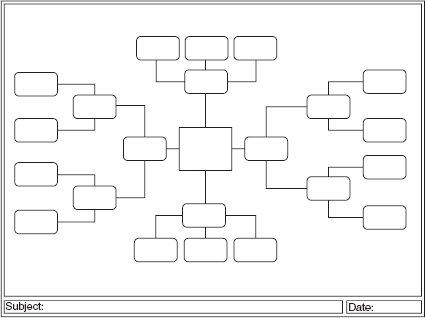
Figure A.1 Mind Mapping
- The Cornell System: The Cornell System is a simple but effective system of note taking. It was devised in the 1950s by Walter Pauk, professor of Education at Cornell University, New York. In this system, we have to leave about 3.5 inches space from the bottom of a sheet of paper and draw a line across the width of the page to mark this space. Draw another line from that line to the top, about 2.5 inches from the left-hand edge of the sheet. Now you have divided your sheet into three sections, the largest section is the ‘notes column’. Take down notes in this space—you can outline or mind map or whatever is suitable to you. Write legibly. The column on the left is the ‘recall column’, wherein you write a series of cues, hints or questions about the corresponding item you have just taken down in the notes. Now cover the ‘notes column’ and use the ‘recall column’ to help you remember facts, ideas and information of the lecture as completely as you can. Then, uncover your notes and verify what you have recalled. Then in the bottom section write a short, 2–3-line summary in your words of the notes you have taken down. This helps you process the information, provide a useful reference when you are trying to find something in your notes later and transfer facts and ideas to your long-term memory. Figure A.2 gives you the format of the ‘The Cornell System’ of note taking.

Figure A.2 The Cornell System
Making Notes from Text
Go back to the reading chapter and see what we had said about comprehension. One of the best ways to comprehend a text is to make notes while you're reading. Good notes will also help you a lot while preparing for your examinations, when you have to quickly read the main points. Here's how you can make the best notes:
- Skim the text briskly to grasp its gist, purpose and key points. At the same time, take notes.
- Read it again, this time more carefully, to find out the development of idea, the main divisions/chapters/sections of the text and their mutual relationships.
- Write down the main points and the subpoints in the order as they appear in the text.
- Rephrase the main points and subpoints into shorter phrases or may be into single words.
- Use schematizing—tables, charts or diagrams—for organizing scientific and technical material.
- Use standard abbreviations to save time. The first few letters of words and phrases can be the functional abbreviations that may be easily understood later. For example, volume: vol; usually: usu; approximately: approx; somebody: sb; especially: esp; secretary: secy; that is: i.e.; compare and contrast: cf; namely: viz; west: w; joule: J; oxygen: O; pages: pp; with effect from: w.e.f.; kilogram: kg; computer: comp; month: mth; magnesium: Mg; specific gravity: sg.
- Signs and symbols are useful tools for making notes. For example, dollar: $; at the rate of: @; percentage: %; not equal to: ≠; infinity: ∞; less than or equal to: ≤; greater than or equal to: ≥; almost equal to: ≈, identical to: ≡; increase: ↑; decrease: ↓; cause: →; results: ←; important: *; and: &, and so on. Don't forget to write out the keys with full forms of the abbreviations and symbols somewhere. It's a good idea to memorize them so that you can use them over and over again.
- Give the notes a proper title to help you recall the main theme as well as the gist.
- Structure your notes in a hierarchical order by inserting headings followed by sub headings, supporting points and may be supporting sub-points. The order of the headings should be logical so as to convey the right attitude of the author. Avoid including more than 3–4 subpoints under a subheading to make the details as simple as possible. If there are more subpoints give them a separate subheading.
- Provide a proper sequencing to the points. You may use capital letters—A B C—for headings, small letters—a b c—for subheadings and Roman numerals—I II III—for supporting points and so on. The arrangement may be altered or reversed as per the need of the text.
- The decimal system of sequencing is another method of arranging the points systematically. Study the following illustration:
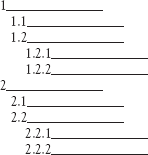
- Write down your comments next to the main points of the notes. This will help you remember later what you were thinking
Passage 1: Making Notes
Read the follow passage carefully and make notes on it. Further, supply a suitable title to it. A robot can be defined as a mechanical gadget that performs functions normally ascribed to human beings. Karel Capek introduced the word ‘robot’ while Sir Isaac Asimov coined the word ‘robotics’, which is a science of dealing with robots. The study of robotics includes the selection of material of proper quality for the components, design, fabrication, design of electronic circuits, computers and computer programming and its control. The science of robots is still in the development stage and a lot of research is being pursued to make robots more suitable for working. Depending upon the area in which robots are to be used, robotics is a multidimensional field that includes disciplines such as biology, medical science, psychology, agriculture, mining, various branches of engineering, outer space, etc. At present, robots are mainly used in industries. These industrial robots are reprogrammable and perform a variety of jobs through programmed motions. Basically, there are two types of robots: fixed and mobile. A fixed robot is attached to an immovable platform. It is similar to a human being standing or sitting in a fixed position while doing the work with hands. On the other hand, a mobile robot moves from place to place. The mobility of a robot is due to wheels or legs or other crawling material provided to it. A mobile robot can be given a human shape. However, the actual shape has nothing to do with the real functioning of the robot.
Summarizing
Summarizing is another effective tool that will help you to comprehend your text materials and write them better in your own words. Summarizing essentially means that we reduce a text to its major points. A good summary will give you a clear idea of what a chapter or article is about. Have you seen any scientific article? Many of them have what is called an ‘abstract’ at the beginning (see Figure A.3). Abstracts are similar to summaries, in the sense that they’ll mention in brief what the main text discusses in detail. Some articles also have summaries at the end. Read some abstracts and summaries and see how the main points of the text have been summarized in them.
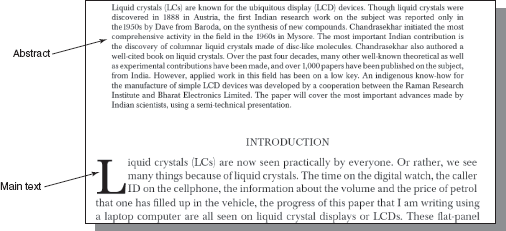
Figure A.3 Example of an Abstract
The two mistakes we usually make when we try to summarize something is, we either write down everything, and mostly copy the text word for word; or forget to write down the important points and write too little to be helpful. Making good summaries is difficult, but once you know how to do it, it will help you all your life to learn new things.
Underlining or Highlighting
What are the key ideas in a chapter or passage? Key words are usually marked out in textbooks in bold, and they indicate important points to remember. What are the points raised in each section? Where can you locate the answer in that section? In a well-written article, usually each large paragraph will have at least one important point. Read through paragraphs to identify the point it is making.
A great way to learn to highlight is to read a newspaper or magazine article and highlight only those lines that answer the questions: ‘what’, ‘when’, ‘where’, ‘why’ and ‘how’. Once you get used to this, it will be easier to quickly read and highlight.
Jotting Down the Key Points
From the underlined or highlighted sections, now write down, in your own words, the main points of those sections. If a chapter has 2,000 words, your summary should at the most have 200 words. Start with reducing the size of the summary to 100 words, then to 50, and then as short as you can make it. Can you sum up one chapter in a single sentence?
Exercises
-
Imagine that you are putting in an ad, you have Rs 1,000 and you pay Rs 10 for every word you use. Now, go through a chapter you are reading and create a summary within your ‘budget’.
-
In most interviews, you are asked to say something about yourself. Try this exercise:
- If you were to describe yourself in one sentence, how would you do it?
- If you had one last wish to make, what would it be?
- Name three books you really like. For each book, write the three most important points about why you like them.
Turning Notes to Text
Suppose you have been asked to write something about euthanasia (or mercy killing) in India. Your first task would be to research various articles, books, newspaper reports and the Internet to see what you can find.
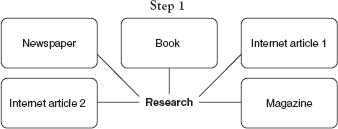
While doing your research, you need to make notes from each article. Ask the ‘wh’ questions mentioned earlier to write down the important points. Make two columns, one for the notes, and one for your comments on each point. Refer to the box on critical thinking in the group discussion chapter for help with writing down comments and asking questions. Do not copy sentences from the articles.
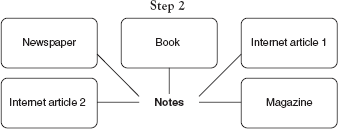
Then, you need to collate, that is, combine, all the notes and turn them into one set of notes and comments.

Exercises
Using the techniques given above, conduct research and create notes on
-
Euthanasia
-
Stem cell research
Organizing Your Ideas
Once you have the basic researched material in place and have collated your points, you need to organize the points and your ideas on them in order. There are several considerations you should have while organizing your material.
First, decide: (a) How long should be your essay? (b) Is it analytical [that is, you judge each point and comment on it], descriptive [you describe the points one after another], or chronological [you describe events in time]? (c) Who is going to read it? These are three very important considerations. Once you've identified the kind of write-up you want to do, you need to organize your ideas in order of importance. Write down the main points without writing full sentences; write the key words that you would want to mention under each point. Specify all the examples you would want to add under each point (see Figure A.4).

Figure A.4 Outlining
You can also use the mind-mapping and Cornell note-taking techniques to organize your ideas. The main questions that you should ask when you are organizing your ideas are:
[For a critical piece]
- For whom am I writing this piece?
- What am I trying to say?
- What are the major points I can state in my favour?
- What kind of criticisms do I anticipate, and how can I answer them?
- Is there any other kind of view that is possible, and why am I not considering it?
For any topic, try answering these questions in one sentence each.
[For a descriptive piece]
- Overview and definition
- Classification of different elements and their description
- Their functions and relations
- Drawings and their descriptions
- Case studies (if any)
- Conclusion
[For a chronological piece]
- Brief description of the event
- The event as it happened
- The end result
- Analyses
You will find that you are much clearer about the purpose, audience, and tone of your writing once you've organized your ideas in these formats.
Grouping
We discussed vocabulary trees in the chapter on speaking. It is important for you to create key word trees or word groups when you are creating outlines for your write-up from your notes. Let's say, for example, that you are writing an essay on a famous architect.
First, write down the key words you would use to describe him:
architect of modern India eminent engineer simple vegetarian teetotaller hardworking honest statesman visionary Bharat Ratna
Then, group the keywords into categories:
| Personal | Achievements |
|---|---|
| simple | architect of modern India |
| vegetarian | eminent engineer |
| teetotaller | statesman |
| hardworking | visionary |
| honest | Bharat Ratna |
This kind of grouping will help you develop a clear plan for writing the piece.
Cohesion and Coherence
Cohesion and coherence refer to the idea that what you say or write should come together as a logical piece; that is, one idea is connected to the next in meaning, each idea follows from another idea, and all the ideas together make up one clear point of view. Cohesion refers more specifically to connections between sentences, while coherence refers to the overall connectedness of ideas in a piece of writing. When audiences/readers ask the question, ‘What was s/he trying to say?’ the answer should be clear in their heads. Refer to what we said in the section on organizing your ideas. Once you have answered the questions given there, the write-up will be automatically much more logically coherent. We'll also discuss the question of coherence later, in the section on paragraph writing.
To make sentences cohesive, you need to ensure the following:
- Have transition words that link sentences. This can be done by repeating some information from sentence A to sentence B. For example:
By 2010, OPEC could easily produce half of the world's oil. This is because OPEC members control such a huge share of the world's high-quality, low-cost oil reserves.
- Link the sentences thematically. Are all the sentences talking about the same thing, but advancing your ideas gradually? For example:
All sentences talk about nuclear reactors, but every sentence gives new information.
A nuclear power reactor uses fission reactions to produce thermal energy that is converted to electrical energy.

One common class of nuclear reactor is the light water reactor which uses light water as a moderator and as a coolant.

There are two types of light water reactors: the pressurized water reactor and the boiling water reactor.
- Have parallel constructions: Sentences are also linked when one piece of information is compared or contrasted with another. For example:
In ordinary speech, the word ‘group’ can mean any organization that involves more than two people. It can even mean crowds of people.

In the social sciences, however, it refers to two or more people who have come together or belong together and are aware of their common connections. This awareness differentiates a crowd from a group.
Memos
In business communication, we often have to send day-to-day information to a specific set of people. Memos are the simplest form of written material. They are written like letters, but are different from letters in two aspects: they are not meant for one particular person and are therefore less private. Secondly, their format also tends to be less formal than that of a business letter. Figure A.5 shows the basic format of a simple memo.
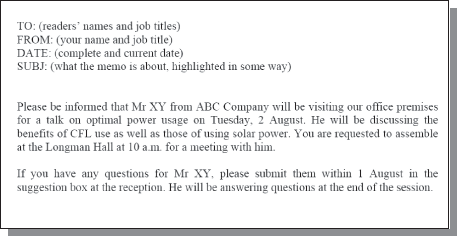
Figure A.5 Sample of a Short Memo
Memos may also be detailed and provide important information about policies, etc. See, for example, Figure A.6.
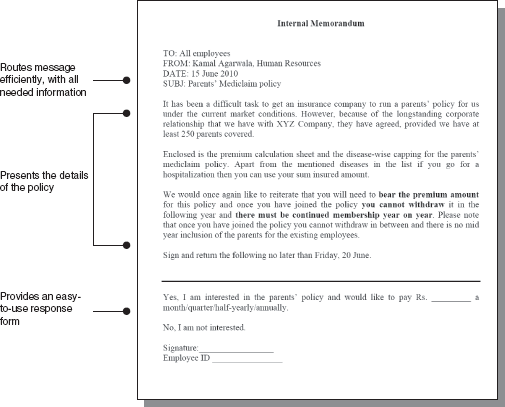
Figure A.6 A Detailed Memo
Narrating Events Chronologically
Have you ever told stories to anyone? Narrative essays, or stories, usually follow a chronological order: first this happened, then this, then this. A narrative essay usually recreates an event for a purpose, that is, you obviously have something to say through a story.
Here's how a narrative essay should be organized: Introduction → First event → Second event → Third event → Ending (with main point).
Now, see the story given below. This is from the Aesop's fables collection.
The Lark and Her Young Ones
A lark had made her nest in the early spring on the young green wheat. The brood had almost grown to their full strength and attained the use of their wings and the full plumage of their feathers, when the owner of the field, looking over his ripe crop, said, ‘The time has come when I must ask all my neighbours to help me with my harvest.’ One of the young larks heard his speech and related it to his mother, asking her where they should move for safety. ‘There is no occasion to move yet, my son,’ she replied, ‘the man who only sends to his friends to help him with his harvest is not really in earnest.’ The owner of the field came again a few days later and saw the wheat shedding the grain from excess of ripeness. He said, ‘I will come myself tomorrow with my labourers, and with as many reapers as I can hire, and will get in the harvest.’ The lark, on hearing these words said to her brood, ‘It is time now to be off, my little ones, for the man is in earnest this time; he no longer trusts his friends, but will reap the field himself.’
Moral of the story: Self-help is the best help.
Exercises
What we've given here is a very basic chronological essay. Now, write at least three paragraphs describing:
-
One of the most frightening experiences in your life.
-
A funny incident.
-
Your first day at school.
-
The lives of your grandparents.
Use the techniques given in the sections on paragraph writing for help.
Paragraph Writing
Have you ever been asked to write paragraphs on a topic? What does this mean? A paragraph is one of the central components of writing. The Oxford Advanced Learners’ Dictionary defines it as ‘a section of a piece of writing, usually consisting of several sentences dealing with a single subject’. A paragraph is ‘a group of sentences or a single sentence that forms a unit’. Ultimately, good paragraphs contain a sentence or sentences unified around one central, controlling idea.
Imagine reading page after page of text without any paragraphs. It would be very difficult to read and comprehend. Therefore, when you are asked to write paragraphs, remember to paragraph often, so you don't scare your readers. Write short sentences, and write short paragraphs, each containing one main idea.
A paragraph begins on a new line even if you have to leave most of the previous line empty. You may leave a line space before a paragraph begins, or you may ‘indent’ the first line of the paragraph.
In this book, we have used an indented style to mark each paragraph.
First line of the paragraph is indented from the left margin
Parts of a Paragraph
Read the sections on note-taking and organizing again. Those sections will help you a lot to proceed from notes to writing paragraphs.
A paragraph is divided into three basic parts:
- The topic sentence or main idea: This is the first sentence of the paragraph. It conveys the main idea of the paragraph to the readers and helps them focus on the theme as well as enables him/her to know what is going to be conveyed in it. You should summarize the main points of your paragraph in the first sentence.
- Subpoints or supporting ideas: The rest of the paragraph consists of a series of sentences that develop, support or explain the main idea. They come after the topic sentence, forming the supporting details or the body of a paragraph. They give detailed information about the main idea through examples, illustrations, facts or stories. The information given in this part should be reliable, convincing and trustworthy.
- The concluding sentence: The concluding or closing sentence is the last sentence of a paragraph. It sums up and restates the main idea as well as the details supported in the paragraph. It is the closing sentence that reminds readers what they should value. You should restate the main idea of the paragraph as well as summarize it using different words.
Writing a Good Paragraph
Writing a good paragraph or an essay involves some stages. You can use the acronym TOWER to recall the five steps involved in writing a paragraph or essay. TOWER stands for thinking, organizing, writing, editing and rewriting.
Pre-writing stage
Thinking Focus on key words and phrases related to your topic. Think about how much information ought to be included for each topic.
Organizing Organize information using techniques like outlining, flow charts, grouping and mind mapping.
Writing Write the first draft of the paragraph or essay.
Editing Look for mistakes in language and in the arrangement of your ideas.
Post-writing stage
Rewriting Correct all errors and write the final version.
The Pre-Writing Stage
Refer to the previous sections on thinking, making notes and organizing your ideas. We've given here a sample outline for paragraph writing.
Developing Outlines for Writing a Paragraph
Example: Reality Shows on TV
Success of reality shows ___________ a few successful shows ___________ provide a platform to the budding talents, amuse us, enhance our knowledge ___________ increase the burden ___________ involve politics ___________ game of power
Reality shows are gaining a lot of popularity these days. In 1995, India's first TV show ‘SA-REGA-MA' was shown on the national channel. As far as TRP (Television Rating Points) is concerned, it was a great success. The show not only had a large viewership but earned a lot of name and fame for its makers. Since then, the reality shows have become a usual practice to gain more and more popularity.
Many shows such as, sa-re-ga-ma-pa, Close Up Antakshari, Meri Aawaz Suno, Indian Idol, Kaun Banega Crorepati?, Bigg Boss, Dus Ka Dum, Star Voice of India, Boogie Woogie and many more have attained a huge popularity. Reality shows are planned according to the taste of the people. These shows are liked as they showcase the talent of the budding artists, provide the audience with healthy entertainment and guide the viewers in the right direction. Shreya Ghoshal, Kunal Ganjawala and Sunidhi Chauhan, the famous singers of the music industry have come from reality shows. Shilpa Shetty gained a lot of popularity as an international artist because of such a show named Big Brother. Some shows give us an opportunity to know the life of the film stars. While laughter shows contribute to the national health by relieving people of their day-to-day stress, the other shows like KBC, Bournvita Quiz Contest enhance our knowledge.
Dance and musical shows provide us with sheer amusement, keep us in touch with the latest trends and at the same time provide us an opportunity to give our judgement. Nevertheless, these shows have many shortcomings too. Such shows have increased burden on children. Not only do their studies suffer but also the pressure of competition gets accumulated them. Besides this, they take us away from our culture. To gain popularity, the show owners include gossip, controversies and fights. It is shown that the people win due to public opinion but it is, in fact, the game of power and money. To conclude, the reality shows are not always real.
Now, based on the above, develop outlines for the following topics: Ragging; The Importance of Technical Education; Engineers: Builders of the Nation.
The Writing Stage
This stage is when you turn your ideas into sentences.
Use language appropriate for your readers: As we stated earlier, the first question you ask when you begin to write paragraphs is ‘Who is going to read this?’
Let us consider these two examples. The first one is from a report published in Science.1
Mammalian histone lysine methyltransferase, suppressor of variegation 39H1 (SUV39H1), initiates silencing with selective methylation on Lys9 of histone H3, thus creating a high-affinity binding site for HP1. When an antibody to endogenous SUV39H1 was used for immunoprecipitation, MeCP2 was effectively coimmunoprecipitated; conversely, a αHA antibodies to HA-tagged MeCP2 could immunoprecipitate SUV39H1.
This kind of language would be extremely difficult for most students to understand, not to mention being very technical. This is best suited for highly specialized research articles. Now see this:
When a heart attack occurs, the dying part of the heart may trigger electrical activity that causes ventricular fibrillation. This is an uncoordinated twitching of the ventricles that replaces the smooth, measured contractions that pump blood to the body's organs. Many times if trained medical professionals are immediately available, they can use electrical shock to start the heart beating again.
If the heart can be kept beating and the heart muscle is not too damaged, small blood vessels may gradually reroute blood around blocked arteries. This is called collateral circulation.2
For the most part, this sample, though technical in theme, uses everyday words like trigger, twitching and blocked. The two technical words, ventricular fibrillation and collateral circulation, are well-defined.
No matter how technical the subject, try to use simple language so that your readers can understand what you're saying. Avoid using long words: say use instead of utilize; Don't initiate and terminate things—start and stop them.
Use a reasonable sentence length: Long sentences are difficult to read and will bore your readers. Sentences that exceed 40 or 50 words are too difficult for most people to read. Professional writers try to keep the average sentence length at 20 words or so.
Organize your ideas in space and time: This is an important consideration, especially in the description of events or processes. Are you writing about an event? Remember to develop a clear time outline based on how something happened. What are the related stories you want to develop along each point?
| Describing an Event | |
|---|---|
| What happened | Describe the events in brief and give an introduction to the paragraph, including what you plan to do. |
| When did it happen? | Develop a detailed timeline of what happened after what. Add subpoints next to each point for your comments. |
| Analysis | What is your overall opinion/stance? Summarize and critically review the points to come to a conclusion about the event. Suggest points for action if you wish to. |
| Describing a Process | |
|---|---|
| What are you describing? | Give an idea, in brief, of what you trying to describe. Provide definitions and examples. |
| Outlines for the process | Precisely identify every step in your outline, where one step follows from another. Every step should have the following elements: the definition of the process, how it happens, and its functions and uses. Accompany the steps with diagrams and figures, if necessary. Figures should be properly labelled. |
| Conclusion | Summarize all the points discussed. |
Ensure coherence: As we discussed earlier, coherence means a logical relationship between the ideas and the presentation. For a paragraph to be coherent, the sentences should be arranged in a logical manner and should follow a definite plan for development. To achieve coherence in a paragraph, you need to use pronouns and linking words appropriately:
- Pronouns—this/that/these/those— should be used carefully to maintain continuity; otherwise, they will confuse readers.
- Sentence linkers such as first/meanwhile/later /afterwards/finally/at that time/at that very moment/next to/in front of/besides can be used to join sentences in space and time.
- Sequence words like between/behind/after/then/now are used to show chronological order or sequence.
- Linking words—thus/therefore/hence/ however/as a result of/accordingly/due to/owing to/consequently/similarly/likewise/yet/nevertheless/on the other hand/on the contrary, etc.—present the objects or situations in comparison or contrast to one another as well as explain them.
- Transition words—furthermore/in fact/in addition to/for example/ as an illustration/for instance/in other words, etc.—help the writer describe ideas or objects.
- Conclusion words like to conclude/to sum up/to summarize/in short/in a nutshell conclude or summarize the piece and words such as definitely/certainly/of course/no doubt/undoubtedly restate or reaffirm the ideas.
Provide citations: If you have taken any material/quote, idea from other sources, do not forget to mention the details of the source. Taking material from other sources without acknowledgement is unethical and should be avoided at all costs. Towards the end of this chapter, we've provided a template of a formatted document. You will see that we have referred to three sources for the text and one each for the table and figure. The details of the text sources are given under the ‘Notes’ section.
We shall discuss citation and references in detail in Chapter 9.
The Post-Writing or Editing Stage
When you've written the first draft of the paragraphs using this chapter's guidelines, it is a good idea, especially if you are writing alone, to share it with a friend or, even better, one of your identified readers. Ask this person to read your draft, check it for accuracy and completeness, and suggest ideas for revision. Then revise it again, if necessary, taking in your reader's suggestions.
If you are writing with others, your team will need to combine your revised individual sections into a common document. It is very important to check such a document for consistency in language, style and overall coherence, since different people have different ways of writing.
Exercises
Use a sample of your own writing to see whether you can improve it using the guidelines described in this chapter. Identify paragraphs, sentences, or word choices that could be improved. Describe your writing and explain why the portions you have identified need revision, and then revise them.
You must, yourself, check the word choices, spellings, grammar, punctuation, handwriting and form. There should be no long, unwinding sentences, no repetitions, no complex examples or difficult terms. Instead of definitions, give examples and supporting details. No irrelevant information should be given. Read your paragraph again. Make sure each sentence has a subject. See if the subjects and verbs agree with each other. Check the verb tenses of each sentence. Make sure that each sentence makes sense, your paragraph has a topic sentence and your supporting sentences focus on the main idea. Ensure that you have a closing sentence. Finally, see if your paragraph is interesting.
Subject-Verb Agreement
The basic principle of subject–verb agreement is that singular subjects need singular verbs; plural subjects need plural verbs.
Important points to remember:
- The indefinite pronouns anyone, everyone, someone, no one, nobody are always singular and, therefore, require singular verbs. Everyone is, Someone has, Each of the students is, etc.
- The word ‘some’ may or may not take a plural verb, depending of what they are referring to: Some of the cards are, Some of the water is, etc.
- Phrases such as together with, as well as, and along with are not the same as and:
The policeman as well as his brothers is going to prison.
The policeman and his brothers are going to prison.
- Either and neither take singular verbs: Either of them is fine; Neither of them is okay.
- Or and nor take singular or plural verbs, depending on the subject closer to the verb:
Either my sister or my brothers are going to the market.
Neither my brothers nor my sister is going to the market.
Are either my brothers or my sister going?
Is either my sister or my brothers going?
Find out more about subject-verb agreement in order to be confident about your written English.
Editing and proofreading your draft: Refer to the section on organizing your ideas. We had given a sample of grouping key words to write a paragraph on an architect. Now, after going through the sections on pre-writing and writing, imagine that you have written a rough draft. See this draft given here.
Exercises
Editing a Draft Paragraph
Check and correct all spelling, grammar, punctuation and other errors that you can locate in the document. Rewrite it to make it better and add paragraph breaks wherever necessary. What words would you change and why? We've solved this one for you at the end of the chapter, but refer to it only after you have done the work yourself.
Sir Mokshagundam visvesvaraya was an eminent engineer and statesman who played a key role in building of modern India. He received our country highest honour, the Bharat Ratna in 1955. He was responsible for building the very first electricity generation plant in Asia at Shivanasamudram near Mysore in 1894. He had many acheivement to his credit these include implementing an extremely intricate system of irrigation in the Deccan area, designing and patenting a system of automatic weir water floodgates, and supervising the construction of the KRS dam across the Cauvery River from concept to inauguration. The automatic flood gates designed were first installed in 1903 at the Khadakvasla reservoir near Pune. These gates were employed to rise the flood supply level of storage in the reservoir to the highest level likely to be attained by its flood without causing any damage to the dam. Based on the success of these gates, the same system was installed at the Tigra dam in Gwalior and the Krishnaraja Sagara (KRS) dam in Mysore. Visvesvaraya achieved celebrity status when he designed a flood protection system to protect the city of Hyderabad floods. He was also instrumental in developing a system to protect Vishakapatnam port from sea erosion. Sir M. V. supervised the construction of the KRS dam across the Cauvery River from concept to inauguration. This dam created the biggest reservoir in Asia at the time it was built. During his period of service with the Government of Mysore state, he was responsible for founding of under the aegis of that government the Mysore Soap Factory, the Parasitoid laboratory, the Bhadravati Iron & Steel Works, the SJ Polytechnic Institute, the Bangalore Agricultural University, the State Bank of Mysore, the Mandya Sugar Mills and numerous other industrial ventures. He also encouraged private investment in industry during his tenure as Diwan of Mysore.
Once you've edited the draft and made all the changes, you need to go through the text again, that is, proofread the text, to see that all errors have been taken care of. Now your text material is ready to be styled and formatted.
Styling and formatting your text: Even if your text is well-written and edited, it will be difficult to read if the font size is too small or too large. If the write-up is long, then appropriate headings are necessary to break up the text thematically. Follow the basic guidelines of division from the outlines you initially created (Main idea, subpoints, examples, etc.). Add a heading to every main idea, and the paragraphs will be easier to read.
The standard format is to type your text in 12 pt, Times New Roman. Justify the text, provide paragraph breaks in the form of new lines or indents, provide a title to the document and headings for every main idea. The text will be easier to read if you double-space it. Set wide margins so that the text doesn't look very heavy on the eye.
The title should be centre-aligned, in a larger and/or different size, and the headings should also stand out. Let's review the sample document here. Note all the elements that have been formatted. If you have figures, tables, and other elements, they need to be typed in a different font size/type.
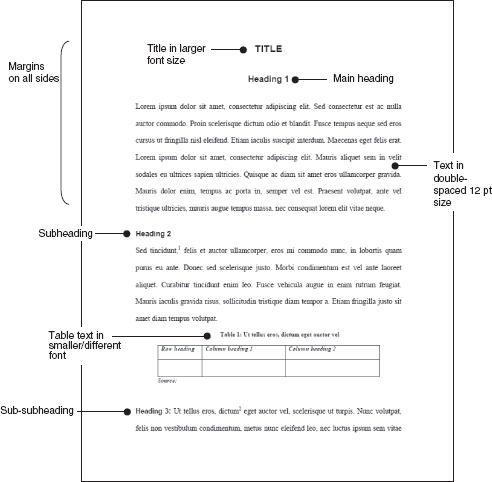
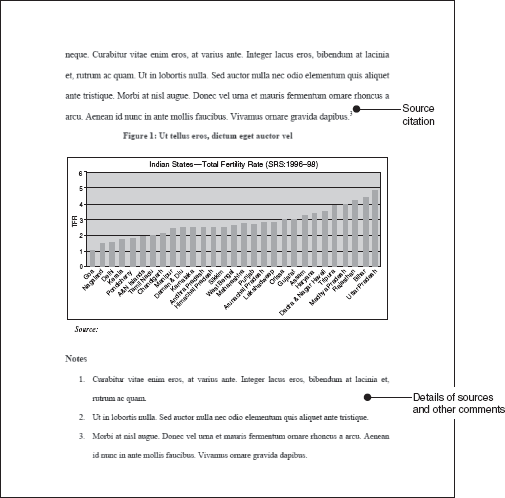
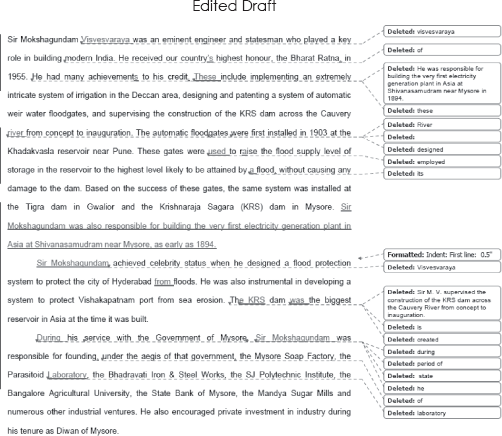
Sir Mokshagundam Visvesvaraya was an eminent engineer and statesman who played a key role in building modern India. He received our country's highest honour, the Bharat Ratna, in 1955. He had many achievements to his credit. These include implementing an extremely intricate system of irrigation in the Deccan area, designing and patenting a system of automatic weir water floodgates, and supervising the construction of the KRS dam across the Cauvery river from concept to inauguration. The automatic floodgates were first installed in 1903 at the Khadakvasla reservoir near Pune. These gates were used to raise the flood supply level of storage in the reservoir to the highest level likely to be attained by a flood, without causing any damage to the dam. Based on the success of these gates, the same system was installed at the Tigra dam in Gwalior and the Krishnaraja Sagara (KRS) dam in Mysore. Sir Mokshagundam was also responsible for building the very first electricity generation plant in Asia at Shivanasamudram near Mysore, as early as 1894.
Sir Mokshagundam achieved celebrity status when he designed a flood protection system to protect the city of Hyderabad from floods. He was also instrumental in developing a system to protect Vishakapatnam port from sea erosion. The KRS dam was the biggest reservoir in Asia at the time it was built.
During his service with the Government of Mysore, Sir Mokshagundam was responsible for founding, under the aegis of that government, the Mysore Soap Factory, the Parasitoid Laboratory, the Bhadravati Iron & Steel Works, the SJ Polytechnic Institute, the Bangalore Agricultural University, the State Bank of Mysore, the Mandya Sugar Mills and numerous other industrial ventures. He also encouraged private investment in industry during his tenure as Diwan of Mysore.
